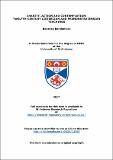Files in this item
Charity, action and contemplation : twelfth-century Cisterician and Premonstratensian teachings
Item metadata
| dc.contributor.advisor | Hyland, William P. | |
| dc.contributor.author | Bandeniece, Beatrise | |
| dc.coverage.spatial | [6], 171 p. | en_US |
| dc.date.accessioned | 2017-11-13T13:30:30Z | |
| dc.date.available | 2017-11-13T13:30:30Z | |
| dc.date.issued | 2017-12-07 | |
| dc.identifier.uri | https://hdl.handle.net/10023/12069 | |
| dc.description.abstract | The aim of this thesis is to examine twelfth-century Cistercian and Premonstratensian texts in order to discern teachings about charity, action and contemplation. Previous scholarship has differentiated Cistercian and Premonstratensian attitudes towards teaching, action and contemplation. This thesis analyses texts to discern whether there are differences between Cistercians and Premonstratensians in terms of their attitudes towards charity, action and contemplation, and whether they connect these terms. Building on conclusions reached by previous scholarship, this thesis proceeds by providing context and detailed analyses of these works. The first chapter examines the history of monasticism from the third until the twelfth century: the origins of monasticism, Western monastic development with particular regard to Cistercians and Premonstratensians, medieval rules, as well as medieval education and exegesis. The second chapter views Cistercian teachings within De consideratione by Bernard of Clairvaux and The Mirror of Charity by Aelred of Rievaulx. It first introduces the life and works of Bernard and Aelred, then provides the context for each text. Texts are analysed in terms of content, structure, themes, as well as claims and justifications concerning charity, action and contemplation, using the Latin text in order to discern where authors use such terms as “caritas”, “contemplatio” and others. The third chapter proceeds in the same manner, viewing Premonstratensian texts: Epistola apologetica and Book One of Anticimenon by Anselm of Havelberg; On the Knowledge of Clerics by Philip of Harvengt and Sermon XII by Adam Scot. This thesis draws several conclusions: charity is an underlying concept in all the texts. Discussing meditation or reading may imply contemplation. Teachings concerning action and contemplation differ regardless whether the writer is Cistercian or Premonstratensian. Philip of Harvengt is closest to combining all three terms in his teachings. | en_US |
| dc.language.iso | en | en_US |
| dc.publisher | University of St Andrews | |
| dc.subject | Monasticism | en_US |
| dc.subject | Medieval monasticism | en_US |
| dc.subject | Cistercian | en_US |
| dc.subject | Premonstratensian | en_US |
| dc.subject | Norbertine | en_US |
| dc.subject | Contemplation | en_US |
| dc.subject.lcc | BX3415.B2 | |
| dc.subject.lcsh | Cistercians--Customs and practices | en |
| dc.subject.lcsh | Premonstratensians--Customs and practices | en |
| dc.subject.lcsh | Monasticism and religious orders | en |
| dc.subject.lcsh | Charity--Religious aspects--Christianity | en |
| dc.subject.lcsh | Contemplation | en |
| dc.title | Charity, action and contemplation : twelfth-century Cisterician and Premonstratensian teachings | en_US |
| dc.type | Thesis | en_US |
| dc.type.qualificationlevel | Masters | en_US |
| dc.type.qualificationname | MPhil Master of Philosophy | en_US |
| dc.publisher.institution | The University of St Andrews | en_US |
This item appears in the following Collection(s)
Items in the St Andrews Research Repository are protected by copyright, with all rights reserved, unless otherwise indicated.

